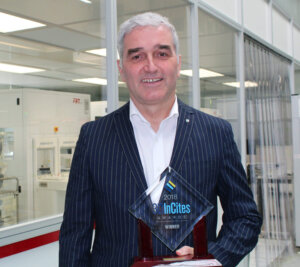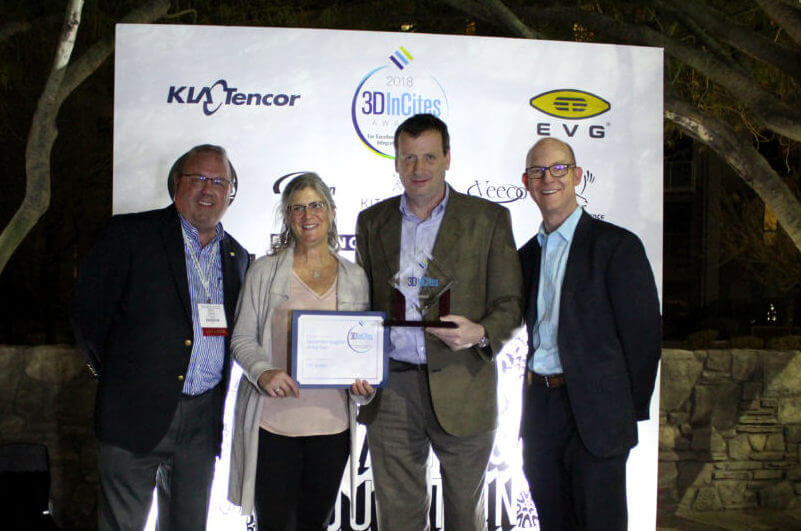
It used to be that people thought about metrology for front-end process control and inspection for advanced packaging. As wafer level packaging (WLP) and heterogeneous integration (HI) approaches became more advanced, metrology processes began creeping into back-end process control, where measurement becomes trickier and more diversified. As part of the 3D InCites Award Winners series, I spoke with Thomas Fries, CEO of FRT, winner of Equipment Supplier of the year. We talked about how technology diversification is here to stay, and how hybrid metrology solutions using multi-sensor technology are becoming necessary.
Metrology for Advanced Packaging
“For the past two years, we’ve had a strong demand for tools that perform different metrology tasks,” noted Fries. “Inspection used to be the standard, but now metrology is becoming a must-have.” He went on to explain the impact the lack of mainstream processes is having on metrology solutions providers.
Despite continued efforts to scale CMOS structures to smaller nodes, metrology needs are fairly straightforward thanks to standardization of tools and processes. This is not the situation for metrology in the advanced packaging space. Measuring total thickness variation (TTV) on a wafer is not the same as measuring TTV with a very high lateral resolution. Additionally. through silicon vias (TSVs), Cu bump or pillar heights, as well as thinning, bonding and stacking are bringing new metrology needs compared to classical process steps.
Diversity changes everything
The dawn of fan-out (FO) processes both at the wafer and panel level has added more diversity to metrology needs. Add to that 2.5D and 3D heterogeneous integration, and now chiplet technologies and the diversity of the space continues to broaden. This is not the volume-driven market tier-one metrology tool providers are used to serving.
“Not only do we have to accommodate measurement requirements for different processes, we need to be able to handle both wafers and panels, thinned and bonded wafers, and film frames,” noted Fries, adding that he doesn’t expect the players to settle on one approach for all, because different applications call for different device architectures, which in turn require different processes. He does, however, expect a narrowing of options.
“For FRT this is a fantastic situation,” said Fries. “Our early decision to focus on building tools with multiple sensors and to program our own software in-house is paying off. We are perfectly set up for doing hybrid metrology with multi-sensor technology, which is what is needed for these complex processes.”

The hybrid metrology solution
So what exactly is hybrid metrology? Fries explains that for FRT, it means using its multi-sensor concept so that in one recipe, different properties on a device can be automatically measured. The systems feature up to ten fully integrated sensors that are fully automated by a single recipe. By the magic of FRT’s software developed in-house, these sensors act as one to automatically integrate different information and create new information that isn’t directly available. This makes it possible to measure things that previously couldn’t be measured.
Fries explained further: In the same tool, you can now, for example, measure the height of a Cu bump against the oxide in silicon in the same machine. The step height of the Cu is measured optically, and a film thickness sensor is used to measure oxide thickness. By subtraction, the film thickness, the height of the Cu above the oxide can be determined.
Additionally, with the company’s third generation of tools, the up-to-date software achieves 64-bit status. This so-called hybrid metrology tool is the perfect fit for diversified markets, says Fries. “It paradoxically solves what the customer wants: a standard tool that can follow an established roadmap with on-site upgrades and can also handle diverse process steps and the ability to customize solutions,” he said.
Serving niche markets
Fries firmly believes that the key to success does not lie in trying to be all things to all people. With this in mind, his strategy is to focus on three growing specific markets: advanced packaging, MEMS, and LED applications.
“The market is interesting and gives us lots of options. But it’s important that we focus on niche markets and not try to do everything,” he said. “The newest, hottest applications call for new processes, and metrology tools have to be flexible to adapt to new process quickly. This isn’t what the tier-one suppliers focus on. They aren’t keen on serving the niche markets because the low volumes don’t make it worthwhile for them.”
As a result, he says the competitive overlap is diminishing. “We don’t meet most of those competitors in the market anymore,” notes Fries. “There’s room for all of us to succeed.”
The best of both worlds
What Fries likes best about FRT is having the flexibility and capability to serve both niche and high-volume markets. The company’s hybrid metrology and inspection solutions suit the current climate of application diversity perfectly. Usually, a company decides to pursue tier-one or niche customers. This is not the case for FRT. Even though they focus on serving the niche markets, their toolbox allows them to support both, combining the best of both worlds.























